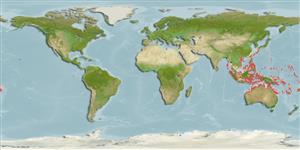Common names from other countries
>
Ovalentaria/misc (Various families in series Ovalentaria) >
Pomacentridae (Damselfishes) > Pomacentrinae
Etymology: Chrysiptera: Greek, chrysos = golden + Greek, pteron = fin, wing (Ref. 45335).
More on author: Snyder.
Environment: milieu / climate zone / depth range / distribution range
Ecologia
marinhas associadas(os) a recifes; não migratória; intervalo de profundidade 1 - 20 m (Ref. 48636). Tropical; 34°N - 23°S
Indo-West Pacific: Ryukyu Is., Taiwan, Palau, Indonesia, and offshore reefs of Western Australia.
Tamanho / Peso / Idade
Maturity: Lm ? range ? - ? cm
Max length : 7.0 cm TL macho/indeterminado; (Ref. 9710)
Descrição breve
Chaves de identificação | Morfologia | Morfometria
Espinhos dorsais (total) : 13; Raios dorsais moles (total) : 13 - 14; Espinhos anais: 2; Raios anais moles: 13 - 14.
Adults are found in 1-6 m (Ref. 7247) and in coastal to outer reef crests to depths of about 20 m (Ref. 48636). They occur solitarily or in groups in reef margins and upper seaward slopes subject to mild surge (Ref. 9710). Feed mainly on algae. Oviparous, distinct pairing during breeding (Ref. 205). Eggs are demersal and adhere to the substrate (Ref. 205). Males guard and aerate the eggs (Ref. 205). Diurnal species (Ref. 113699).
Life cycle and mating behavior
Maturities | Reprodução | Spawnings | Egg(s) | Fecundities | Larvas
Oviparous, distinct pairing during breeding (Ref. 205). Eggs are demersal and adhere to the substrate (Ref. 205). Males guard and aerate the eggs (Ref. 205).
Allen, G.R., M.V. Erdmann and E.M. Kurniasih, 2015. Chrysiptera caesifrons, a new species of damselfish (Pomacentridae) from the south-western Pacific Ocean. J. Ocean Sci. Found. 15:16-32. (Ref. 103843)
Categoria na Lista Vermelha da IUCN (Ref. 130435)
Can't connect to MySQL database (fbapp). Errorcode: Too many connections
